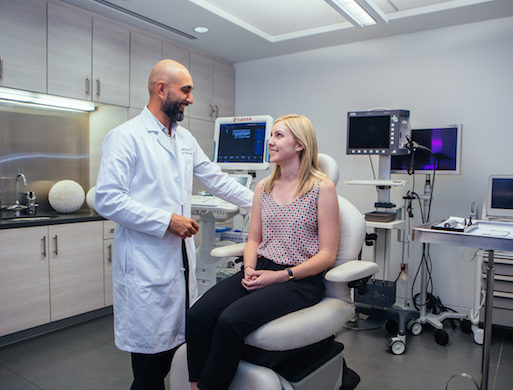Hyperparathyroidism (HPT) is a medical condition in which the parathyroid glands produce excessive amounts of parathyroid hormone (PTH) in the blood. HPT has many difficult symptoms, including muscle weakness, bone and joint pain, concentration and memory issues, abdominal pain, and frequent urination. Some patients with HPT may also feel a lump in the neck.
HPT is treatable, especially if caught early, but leaving it untreated can lead to life-threatening complications such as osteoporosis and kidney disease. Not only that, but HPT is also linked to several types of cancers. In this article, we’ll explore the connection between hyperparathyroidism and cancer.
What is Hyperparathyroidism?
PTH maintains steady levels of calcium in the blood. HPT occurs when one or more of the parathyroid glands become enlarged and produce large amounts of parathyroid hormone. A high level of PTH leads to high calcium levels in the blood, impacting various body systems including the bones and muscles, brain, gastrointestinal system, and kidneys.
Hyperparathyroidism in Cancer Patients
A growing body of scientific evidence tells us that HPT is associated with numerous cancer types, including parathyroid cancer and thyroid cancer as well as skin, breast, colon, rectal, and kidney cancers. Studies also show that HPT increases the risk of malignant cancers. A study based on data from the Danish cancer care registry showed that patients with HPT have 25% increased risk of cancers.
Hyperparathyroidism and Parathyroid Cancers
Around 0.5% to 5% of HPT is caused by parathyroid cancer—that is, by a malignant tumor in the parathyroid. As of now, we know that certain factors, such as radiation therapy in the head, neck or breast region, and genetic disorders like hyperparathyroidism-jaw tumor syndrome, multiple endocrine neoplasia type I (MEN1) and familial isolated hyperparathyroidism (FIHP), increase the risk of parathyroid cancer.
High calcium levels in blood is one of the chief indicators of HPT, and thus the risk of parathyroid cancer. If your blood reports show high serum calcium levels or if you experience any of the symptoms discussed above, you should get a consult from a board-certified parathyroid specialist.
Parathyroid cancers are aggressive cancers and should be caught and treated early. For this condition, the only treatment is the complete removal of the affected parathyroid gland. If the tumor isn’t removed completely, recurrence of the cancer is extremely likely.
Hyperparathyroidism and Thyroid Cancer
A study published in BMC Surgery showed that the incidence of papillary thyroid cancer is high in patients with primary and secondary HPT. Papillary thyroid cancer is the most common type of thyroid cancer, which usually forms on one lobe of the thyroid gland. The study also found that thyroid tumors more than 1 cm in size were seen only in patients with primary hyperparathyroidism.
Thyroid cancer spreads very fast and can affect the lungs, bones and other body parts. Its symptoms include persistent cough, hoarseness of voice, neck pain which radiates to the ear, swelling in the neck, and difficulty breathing and swallowing. If you experience any of these symptoms alongside the symptoms of HPT described above, it is likely your HPT may have led to thyroid cancer. Consult a thyroid specialist immediately.
Hyperparathyroidism and Breast Cancer
Breast cancer is among the leading cancers in women in the US. Around 30-40% of women with malignant breast cancers do show high calcium levels in blood at some point during their illness. In these cases, high calcium levels in blood usually indicate spread of cancer to the bones, but it may also be caused by primary hyperparathyroidism. Moreover, women with primary hyperparathyroidism are more likely to have breast cancer than women who don’t. In women with breast cancer and high serum calcium levels, parathyroid hormone levels are usually checked to find out if the underlying cause of high calcium levels is HPT.
The Hyperparathyroidism and Cancer Connection—Possible Theories
So, we know that HPT and cancers are associated, but how do we explain the link between them? There are several theories that have been proposed so far.
Some research shows that high calcium levels in blood triggers cell division. Cancer cells, by nature, do not stop multiplying or die off, so runaway cell division caused by high blood calcium levels could conceivably lead to cancerous growth.
A few studies have also pointed out that high parathyroid hormone levels promote tumor development and inhibit cell death. Some other studies say that low levels of vitamin D, which is a prominent feature of HPT, may also increase cancer risk.
The evidence shared by these studies, however, is unfortunately not yet definitive. Scientists are still trying to find out the exact mechanisms that explain why cancer and HPT coexist, so for the moment these theories are not yet proven.
When to See a Doctor about HPT
As noted above, untreated HPT may lead to serious health issues. Many studies have shown that in addition to cancer, HPT is also linked with life threatening heart and kidney disease. Hence, it is important to be watchful for hyperparathyroidism symptoms and signs, and if you have HPT, get it treated early to prevent complications.
If you experience symptoms of HPT and your blood reports show alterations in P and calcium levels, you should get an appointment with a parathyroid expert. Dr. Babak Larian of the CENTER for Advanced Parathyroid Surgery is a parathyroid expert in treating HPT safely and effectively. He performs a minimally invasive parathyroidectomy (MIP) with a high success rate and minimal scarring. An MIP can usually be completed in under 20 minutes and is followed by a four-gland assessment that ensures patients can maximize their surgery results.
References:
1. HyperparathyroidMD. Is there a connection between hyperparathyroidism and cancer. Available at:
2. Pickard AL, Gridley G, Mellemkjae L, Johansen C, Kofoed-Enevoldsen A, Cantor KP, Brinton LA. Hyperparathyroidism and subsequent cancer risk in Denmark. Cancer. 2002 Oct 15;95(8):1611-7. doi: 10.0.3.234/cncr.10846. PMID: 12365007.
3. Serena Palmieri, Letizia Roggero, Elisa Cairoli, Valentina Morelli, Alfredo Scillitani, Iacopo Chiodini, Cristina Eller-Vainicher . Occurrence of malignant neoplasia in patients with primary hyperparathyroidism. European Journal of Internal Medicine. Volume 43, September 2017, Pages 77-82
4. Michels KB, Xue F, Brandt L, Ekbom A. Hyperparathyroidism and subsequent incidence of breast cancer. Int J Cancer. 2004 Jun 20;110(3):449-51. doi: 10.0.3.234/ijc.20155. PMID: 15095313.
5. Rodrigo Arrangoiz, et al. Is Breast Cancer Associated with Primary Hyperparathyroidism?. American Journal of Otolaryngology and Head and Neck Surgery.2019. Volume 2(1). Article 1033
6. Goswami S, Ghosh S. Hyperparathyroidism: cancer and mortality. Indian J Endocrinol Metab. 2012 Dec;16(Suppl 2):S217-20. doi: 10.0.16.7/2230-8210.104042. PMID: 23565381; PMCID: PMC3603029.
7. Karaköse M, Kocabaş M, Can M, Çalışkan Burgucu H, Çordan İ, Kulaksızoğlu M, Karakurt F. Increased incidence of malignancy in patients with primary hyperparathyroidism. Turk J Med Sci. 2021 Aug 30;51(4):2023-2028. doi: 10.0.15.66/sag-2012-18. PMID: 33957725; PMCID: PMC8569777.


